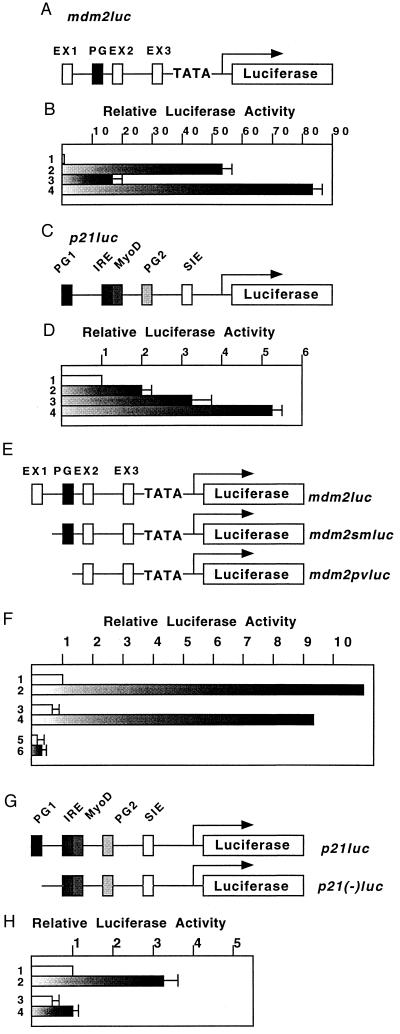Figure 2.
BRCA1 stimulates genomic promoters containing p53-responsive elements. (A) Genomic organization of the murine mdm2 promoter. The first intron of the 1.0-kb murine mdm2 and adenovirus major late TATA box/TdT initiation signal were cloned into pGL2 vector to generate mdm2luc. Exons 1–3 (EX1–EX3), and p53-responsive elements (PG) are indicated. (B and D) The procedure for luciferase analysis of mdm2luc (B) or p21luc (D) was basically the same with that of Fig. 1. Lanes: 1, pcDNA3 vector; 2, p53; 3, BRCA1; 4, p53 plus BRCA1. (C) Genomic organization of the human p21Waf1 promoter. Human p21Waf1 promoter (2.4 kb) was cloned upstream of luciferase gene of pGL2 vector to generate p21luc. p53-responsive elements (PG1 and 2), interferon-regulatory elements (IRE), MyoD-responsive elements (MyoD), and signal transducers and activators of transcription (STAT) serum-inducible elements (SIE) are indicated. (E) Structure of deletion mutants of mdm2luc. mdm2luc was digested with SmaI or PvuII to generate mdm2smluc or mdm2pvluv, respectively. (F) Activation of mutant mdm2 promoters by BRCA1. Reporter plasmids of mdm2luc (lane 1 and 2), mdm2smluc (lane 3 and 4) and mdm2pvluc (lane 5 and 6) were cotransfected with vector (lane 1, 3, and 5) or BRCA1 (lane 2, 4, and 6). (G) Structure of deletion mutant forms of p21Waf1 promoter. p21luc was digested with SacI to remove the first p53-responsive element (p21(−)luc). (H) Activation of p21luc or p21(−)luc by BRCA1. Lanes: 1 and 3, vector; 2 and 4, BRCA1.

